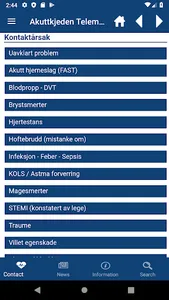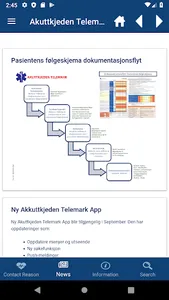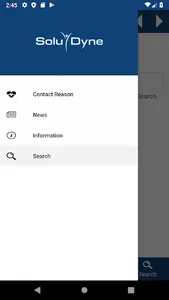The app is a collaboration tool for use by all players in the Telemark emergency chain.
The app has a first page where the menu with Contact Cause, Search, News and information about the Emergency Chain is displayed.
Click Contact Cause to see the list of contact reasons. Click on contact cause to see the workflow showing the patient flow. Click on the activities in the workflow to see the descriptions of each activity.
Click Search to search the contents of the app.
Click on News to read News from the Telemark Emergency Chain.
Click on the Emergency Chain for more information on the Emergency Chain.
The Hamburger menu at the top of the app displays the menu options Home, Search, News, Contact and About.
Click Home to go to the first screen of the app.
Search and News are the same menu items that appear on the Website.
Click Contact to find contact information for Akuttkjeden Telemark.
Click About to find the publisher of the app.
The acute chain is defined as the course of a patient, from an event occurring until the patient is fully assessed and treated. It must involve at least two players, and at least one of these must be AMK, ambulance or hospital.
The app aims to help patients and health professionals experience a well-organized, holistic and predictable course. The goal is for the emergency chain to function without delay in notification, assessment, transport, reception and treatment.
The tool will link the actors' actions together in the emergency package process. The app should be easy to use, easily accessible and perceived as useful to anyone with a role in the emergency chain. By standardizing a patient flow for acute events, packing procedures, variation and differences in patient care are reduced. The tool will help to provide an understanding of the context and overall nature of the emergency health service.
It is important to note that the causes of contact, the onset of patient flow, are based on symptoms and not completed diagnoses. This means that healthcare professionals of each must consider treating the patient regardless of which flow / course triggers an event.
The app has a first page where the menu with Contact Cause, Search, News and information about the Emergency Chain is displayed.
Click Contact Cause to see the list of contact reasons. Click on contact cause to see the workflow showing the patient flow. Click on the activities in the workflow to see the descriptions of each activity.
Click Search to search the contents of the app.
Click on News to read News from the Telemark Emergency Chain.
Click on the Emergency Chain for more information on the Emergency Chain.
The Hamburger menu at the top of the app displays the menu options Home, Search, News, Contact and About.
Click Home to go to the first screen of the app.
Search and News are the same menu items that appear on the Website.
Click Contact to find contact information for Akuttkjeden Telemark.
Click About to find the publisher of the app.
The acute chain is defined as the course of a patient, from an event occurring until the patient is fully assessed and treated. It must involve at least two players, and at least one of these must be AMK, ambulance or hospital.
The app aims to help patients and health professionals experience a well-organized, holistic and predictable course. The goal is for the emergency chain to function without delay in notification, assessment, transport, reception and treatment.
The tool will link the actors' actions together in the emergency package process. The app should be easy to use, easily accessible and perceived as useful to anyone with a role in the emergency chain. By standardizing a patient flow for acute events, packing procedures, variation and differences in patient care are reduced. The tool will help to provide an understanding of the context and overall nature of the emergency health service.
It is important to note that the causes of contact, the onset of patient flow, are based on symptoms and not completed diagnoses. This means that healthcare professionals of each must consider treating the patient regardless of which flow / course triggers an event.
Show More




